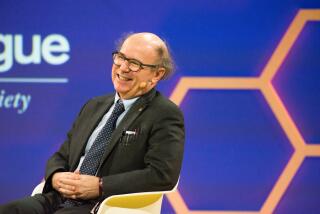Book Review : ‘Beamtimes’ a Look at Little World of Studying Big Ideas
- Share via
Beamtimes and Lifetimes: The World of High Energy Physicists by Sharon Traweek (Harvard: $20; 184 pages)
Tens of thousands of scientists ply their trade throughout the world in disciplines from archeology to zoology. Their task is nothing less than to discover nature’s laws, the unchangeable truths that lie behind the phenomena that we observe.
At the apex of this worldwide search for knowledge stand the physicists, who seek to understand the very nature of matter itself. With some justification, they consider themselves the smartest, deepest, most profound and most far-reaching of all scientists. Physicists have an unshakeable belief that physics is the one true science.
Particle physicists are the elite of the elite. They are the people--experimenters and theorists--who work at the giant accelerators in this country and abroad, trying to understand the most intimate secrets of matter by smashing subatomic particles into each other and studying the resulting debris. People who fail to make it in particle physics go into something else; no one who fails at something else becomes a particle physicist.
“The members of the particle physics community . . . consider themselves members of an intellectual elite, perhaps the intellectual elite, because they believe particle physics works alone at the frontiers of human knowledge,” Sharon Traweek writes in “Beamtimes and Lifetimes,” her insightful study of this community, how it is organized and how it works.
Anthropology at Work
Traweek, an anthropologist at Rice University, put the tools and methods of anthropology to work studying this highly specialized world and came up with remarkable observations, findings and conclusions.
Traweek gets inside the heads of physicists at the Stanford Linear Accelerator Center in Menlo Park, Calif., and, to a lesser extent, the Japanese physicists at their KEK accelerator near Tokyo. She shows their similarities and differences, how their careers are shaped, how they interact with their colleagues, how they do physics and how their ideas about time and space shape their social structure.
Traweek has produced a revealing and intimate look at this exclusive world and its mores. In some ways, of course, it is quite different from other communities, even scholarly communities. These are brilliant people, using state-of-the-art machinery to ask basic questions about how the physical world is made. Traweek explains how they go about it.
But just as interesting is how much like other communities these physicists are. There is an old-boy network for jobs, positions and power. (Traweek notes at several points that there are virtually no women in the world of particle physics, a situation that she indicates is unlikely to change.)
Like Primitive Society
In some ways, the physicists resemble a primitive society. The “traffic in students and postdocs strongly resembles the exchange of women between groups through marriage, which serves as a force in, and source of, some kinship networks,” Traweek writes.
A handful of institutions matter, and the rest are on the periphery. People associated with the important institutions are considered important, and the rest are also-rans. “The only path to the top widely acknowledged by the Americans is the rise of individuals from less prestigious to more prestigious institutions,” Traweek writes. “As some say, ‘Knowledge trickles down and students percolate up.’ They are certain that the best people end up in the best places and the low rank means low merit.”
The physicists believe they are in a meritocracy, but they play hardball politics as much as any corporate climbers. “The desired presentation of self can be characterized as competitive, haughty, and superficially nonconformist,” Traweek says. “Two prominent senior physicists joked that one should ‘behave British and think Yiddish, but not the other way around.’ One group leader said that to convince others of the validity of one’s work one had to have great confidence and be very ‘aggressive. . . .’ ”
In his book, “Nobel Dreams” (Random House: 1987), Gary Taubes profiled part of the world of high-energy physics, focusing on Carlo Rubbia and the CERN atom smasher near Geneva. Traweek paints a broader picture, but no less incisive.
Where Taubes is anecdotal, Traweek is inclusive. The two books mesh together very neatly. They both show how human this ultimate scientific endeavor really is.
More to Read
Sign up for Essential California
The most important California stories and recommendations in your inbox every morning.
You may occasionally receive promotional content from the Los Angeles Times.












